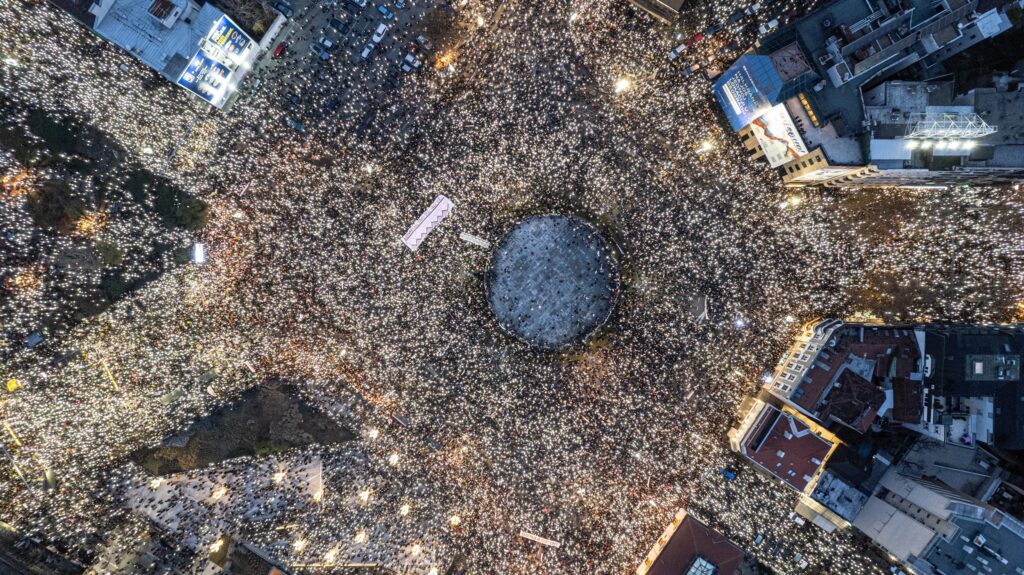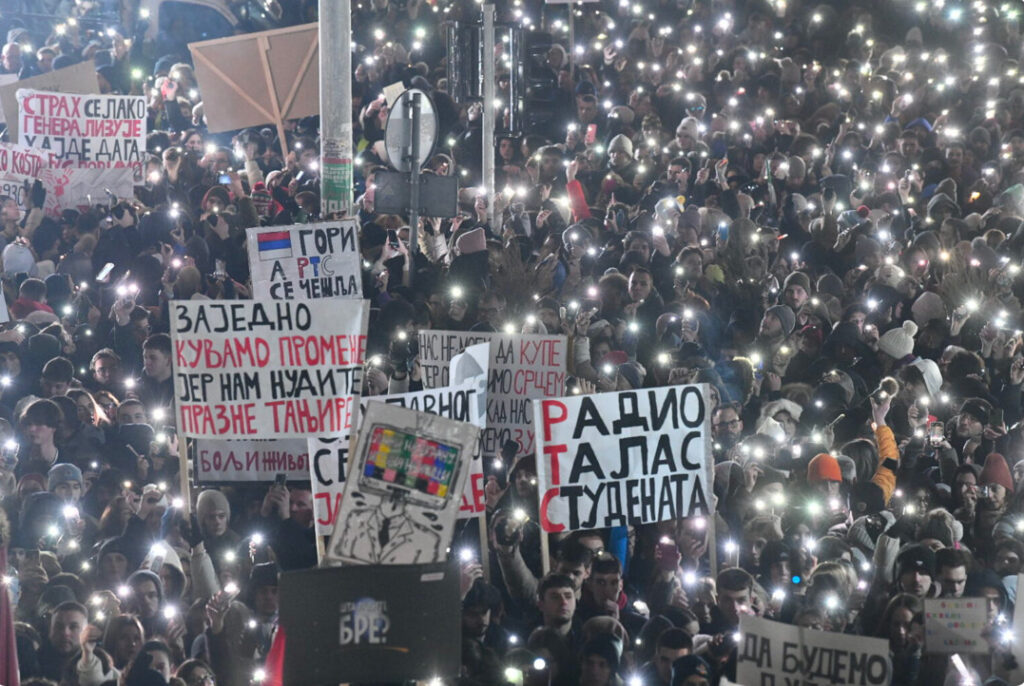Currently, more than 50 faculties from four main Serbian university centers – Belgrade, Novi Sad, Niš and Kragujevac are completely blocked. Students demand responsibility for the accident at the Novi Sad Railway Station when 15 people were killed when the canopy collapsed.

The background of student’s protest
November 1, 2024, 11:52 a.m. was the day when the initial event that sparked the protest begun. On that day, the canopy of the railway station in Novi Sad collapsed on innocent people, killing 15 of them. The same station was renovated several times and inaugurated in order to raise the political rating of the ruling party. At least 65 million euros were invested in the renovation, while 16 million were spent on the building itself. To this day, no one knows where all of this money ended up, and which part of it was actually used solely on reconstruction. This lack of transparency, and an obvious form of corruption, is considered a frequent occurrence here in Serbia, especially by the current government.
November 22, first blockades across the country
After the tragedy, thousands of people started gathering on numerous locations in Serbia at 11:52 every day, blocking the streets and crossroad for 15 minutes, to commemorate each of the 15 victims with a minute of silence – and demand accountability and responsibility for the tragedy, which they see as a result of systemic corruption and negligence. Such suspicions were also raised by some experts, such as Danijel Dašić, a civil engineer and himself an external expert on the Novi Sad railway project, who spoke about the works that led to the collapse, and about the responsibility for this crime. He explained which details during the reconstruction were poorly done, and also explicitly criticized the responsible ministry.
Students in Serbia soon became the main force of the blockades, in particular students of the University of Belgrade, who soon formalized their dissent by formulating several demands and proclaimed a general strike until they are met. One of the students demands, and probably the most controversial and important one, is: “the publication of complete documentation on the reconstruction of the Railway Station in Novi Sad, which is currently illegally hidden, bearing in mind that it is a reconstruction of a public facility and that these documents must be public.”
However, after the first blockades, the biggest problems for students so far appeared. Huge pressures from people close to the regime in order to intimidate young people and extinguish protests. Violent insults and physical attacks during the blockades, unjustified and illegal arrests and detention of students. Blockades got their true epithet right after such pressures – students of the Faculty of Dramatic Arts in Belgrade were attacked by an organized group and officials close to the government. In Novi Sad, during a peaceful protest walk, several persons were deprived of their freedom without explanation or any reason at all. All these events were supposed to serve the purpose of scaring the students and extinguishing the protests, but instead, even greater rebellion was awakened among the people.
This kind of pressures did not come only from the outside. One of the biggest problems that students faced were pressures from by the deans and leading people of their own universities. One of the best examples is the university in the biggest city in south of Serbia-Niš. The faculty of Medicine, which is a state university, faces great challenges and enormous pressures due to ongoing situation in Serbia. Despite the fact that students of that facility want to completely block the whole university, the dean and teaching staff are putting a lot of pressure and are trying to prevent students from protesting by blackmailing them. Targeting is also one of the most common forms of intimidation – writing down the names of protest participants at the university, taking their pictures and recording them.
Of course, in such situations, it happens that a few students remain “neutral”, some out of fear, and some because they know that they will receive privileges from the regime’s professors when (if) the blockade ends. My opinion is that in such situations there is no luxury of “neutrality”. Moments like these, which are crucial for the further development of an entire country, require everyone to choose a side, whether they are for the survival of the dictatorship, or for the student initiative that aims to prevent corruption and eliminate the rot in the system in which we live.
The real picture and proof of the frightening situation in the country, and its institutions, happened during these blockades. The Security Information Agency (BIA), an institution that should work, of course, independently of anyone’s influence in order to protect citizens. As it should be with every other institution. Instead, it happens that invitations and threatening calls and messages to students arrive from this very agency. That is the reality of Serbia, the government has crawled into every pore of this society and law, and will do absolutely everything to stay there and have the strongest influence and control.

(source: Vesna Lalić, Nova.rs)
Darkness of media in Serbia
Special attention should be paid to the darkest period in the history of Serbian journalism and freedom of speech. A perfect example of media darkness is illustrated every day in Serbia. The regime’s media, including the television channels, newspapers and tabloids are probably the most powerful machinery of this government. The spin and targeting of political dissenters has been raised to an extremely worrying level. Students are presented as mercenaries and spies of other countries (in particular of Croatia). The president of the republic himself relativized the crime of a driver who hit a protester and carried him on the hood of his car: „To arrest perhaps the man who was driving the car? How can we arrest a man who has not broken the law? He went his own way“. Similar example of bizarre speeches made on television by people close to the regime is that they say that children are the property of the state… these are just some of the countless outbursts and completely inappropriate statements of the current government, completely supported by controlled media.
Also, public services that should serve the purpose of providing objective and unreserved information to the entire public have reached rock bottom. RTS – a public service whose slogan is “Your right to know everything” opposes every norm of true and real journalism. Instead of serving as a platform of free expression, a platform that can provide a different perspective, it serves solely as a tool of the government that devalues and belittles anyone who disagrees with the dictatorship.
The students expressed their opinion about this very clearly with one of the most massive protests in Serbia in this century. In front of the RTS building, as well as in the surrounding streets, tens of thousands of citizens and students gathered (over 50,000 by some estimates) demanding the awakening of the media, as well as an opportunity for an equal media fight with the state leadership.
Slavija square, December 22, The largest gathering since the beginning of the student protests
A day that showed how influential and massive these protests are, and will be. According to estimates, there were around 100.000 people of all ages at this gathering. From young people and students, to grandparents, as well as parents who came out to support and protect their children. The largest roundabout in the country, and streets next to it, were closed for hours. A hundred thousand citizens paid their respects to the victims in Novi Sad in complete silence. Then they expressed their opinion about the current state of society with a huge noise. Noise which will be very hard to silence in the upcoming months.
The question arises
What kind of society is it, in which young people and others have to worry about whether someone will run them over with a car? Whether someone will attack them physically or verbally because they do not share the same opinion? Well, the most important question, from which all of this started is, whether a concrete structure will suddenly fall on someone’s head and end their life because it was not properly built due to carelessness and corruption?
These are all of the problems that youth and people in Serbia need to face every day, and which make them being exceptionally vocal and active at present.